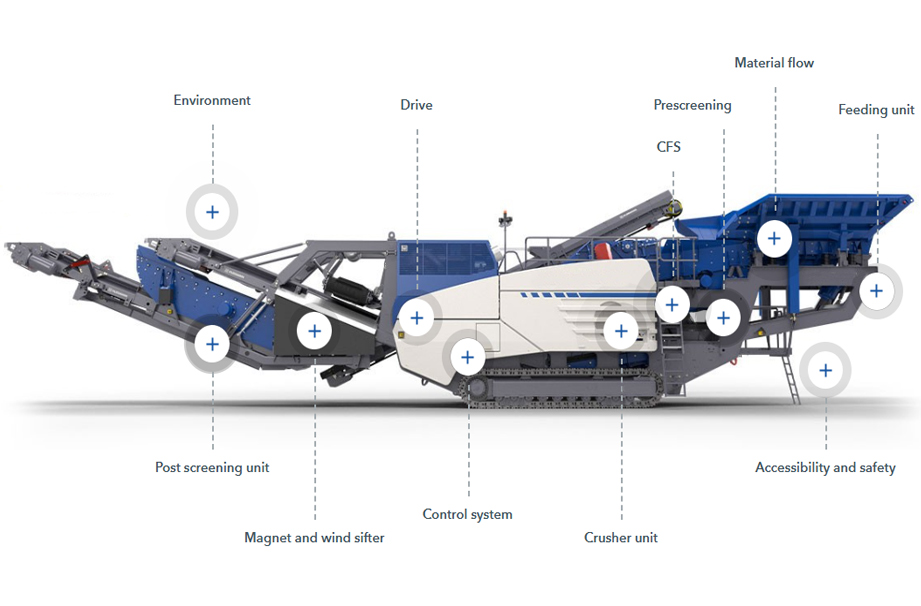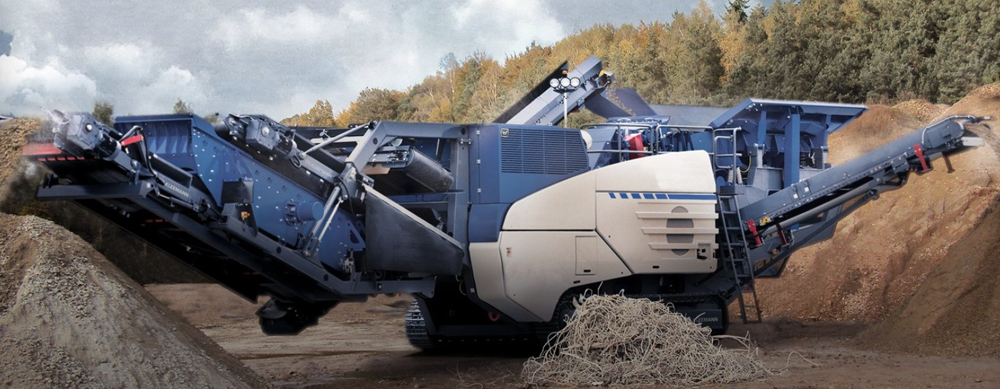An impact crusher is a crucial piece of equipment in the aggregates and mining sectors. It operates on the principle of impact force. The rotor, fitted with hammers or blow bars, spins at high speed. When materials enter the crushing chamber, they are struck by the rapidly moving hammers, shattering them into smaller pieces. This crusher can handle a wide variety of materials, including soft to moderately hard rocks. It features a large feed opening and adjustable settings, allowing operators to control the output size. With its efficient design, impact crushers contribute to enhanced productivity in crushing operations.
| TECHNICAL DATA | |
| Feeding unit | |
| Feed capacity up to approx. (t/h) | 350 |
| Max. feed size (mm) | 880 x 550 x 330 |
| Feed height (with extension) (mm) | 4,190 (4,550) |
| Hopper volume (with extension) (m³) | 4.4 |
| Width x length (with extension) (mm) | 2,100 x 3,700 (2,800 x 3,700) |
| Vibrating feeder | |
| Width x length (mm) | 900 x 2,600 |
| Prescreening | |
| Type | Double-deck heavy-piece screen |
| Width x length (mm) | 1,010 x 2,100 |
| Side discharge conveyor (optional) | |
| Width x length (extended) (mm) | 650 x 4,000 (6,000) |
| Discharge height approx. (extended) (mm) | 2,900 (3,650) |
| Crusher | |
| Impact crusher type | SHB 110-080 |
| Crusher inlet width x height (mm) | 1,100 x 800 |
| Crusher weight approx. (kg) | 13000 |
| Rotor diameter (mm) | 1100 |
| Crusher drive type, approx. (kW) | direct, 310 |
| Adjustment of impact toggles | infinitely variable, fully hydraulic |
| Crushing capacity with demolished concrete up to approx. (t/h) | 240 |
| Crushing capacity with rubble up to approx. (t/h) | 240 |
| Crushing capacity with broken asphalt up to approx. (t/h) | 205 |
| Crushing capacity with limestone up to approx. (t/h) | 265 |
| Discharge chute | |
| Width x length (mm) | 1,200 x 2,400 |
| Crusher discharge conveyor | |
| Width x length (mm) | 1,200 x 9,300 |
| Crusher discharge conveyor | |
| Discharge height approx. (mm) | 3550 |
| Power supply unit | |
| Drive concept | diesel-direct |
| Drive output of Scania diesel engine (kW) | 365 – 371 |
| Generator (kVA) | 135 |
| Post screening unit (optional) | |
| Single-deck post screening unit | |
| > Width x length (mm) | 1,350 x 4,550 |
| > Discharge height of fine grain discharge conveyor approx. (mm) | 3,490 |
| Double-deck post screening unit | |
| > Width x length (mm) | 1,350 x 4,550 |
| > Discharge height of fine grain discharge conveyor approx. (mm) | 3,430 |
| Return conveyor (mm) | 500 x 9,100 |
| Transport | |
| Transport dimensions without options | |
| > Transport height (mm) | 3600 |
| > Transport length approx. (mm) | 17340 |
| > Max. transport width (mm) | 3000 |
| Transport dimensions with post screening unit | |
| > Transport length with single-deck post screening unit (mm) | 21110 |
| > Transport length with double-deck post screening unit (mm) | 21750 |
| > Transport width with screening unit (mm) | 3050 |
| Transport weight | |
| > Transport weight single-deck post screening unit (kg) | 6100 |
| > Transport weight double-deck post screening unit (kg) | 8400 |
| > Transport weight of basic plant – max. configuration (kg) | 44,500 – 60,500 |

1. The frame of an impact crusher is a heavy-duty, rigid structure that provides the overall support for the crusher. It's usually made of thick-walled steel plates or cast steel to withstand the intense forces generated during the crushing process.
2. The rotor is the central component of an impact crusher. It's a cylindrical shaft with a series of hammers or blow bars attached to it. The rotor is typically made of high-strength alloy steel to endure the high-speed rotation and the impact forces when hitting the materials.
3. Impact plates are located inside the crushing chamber and are the surfaces against which the materials are thrown and crushed by the hammers. These plates are usually made of high-strength, wear-resistant materials such as manganese steel or a combination of steel and hard-facing alloys.
4. The feed chute is the entry point for the materials to be crushed. It's usually designed to have a wide opening to accommodate different sizes of raw materials and to ensure a smooth and even feed into the crushing chamber.
5. The bearing system supports the rotor and allows it to rotate smoothly. High-quality bearings are used to withstand the radial and axial loads generated by the rotor's high-speed rotation.
6. A well-designed lubrication system is essential to ensure the smooth operation of the crusher's moving parts. The system supplies lubricating oil to the bearings and other rotating components to reduce friction and wear.

1. For softer materials like limestone or gypsum, a standard-design impact crusher with hammers made of common wear-resistant materials can be sufficient.
2. If the material has a high moisture content, it's important to select an impact crusher with a design that can handle wet materials.
3. Determine the amount of material you need to crush per hour or per day. For small-scale operations such as a local building-material supply yard, an impact crusher with a production capacity of 5-20 tons per hour might be appropriate.
4. Consider the size of the raw materials you'll be feeding into the crusher. The feed opening of the impact crusher should be large enough to accommodate the largest chunks of material.
5. The size of the impact crusher should fit the available space at your production site. Consider the length, width, and height of the crusher.
6. Decide whether the crusher needs to be a stationary installation or if mobility is required. Some impact crushers are designed to be portable and can be easily moved between different job sites.
7. Check the power rating of the impact crusher. The power needed depends on the size and capacity of the crusher as well as the hardness of the materials being crushed.
8. Look for a crusher that is energy-efficient. Some modern impact crushers are designed with advanced drive systems and crushing mechanisms that can reduce energy consumption without sacrificing performance.

The key feature of an impact crusher is its impact-based crushing method. The high-speed rotating rotor, equipped with hammers or blow bars, strikes the incoming materials with great force.
Impact crushers can handle a diverse array of materials. They are not limited to a specific hardness range and can process materials such as limestone, concrete, and even some types of ores.
These crushers offer adjustable settings to control the output size of the crushed material. The gap between the rotor and the impact plates can be adjusted, usually through a mechanical or hydraulic system.
Impact crushers are designed for high-capacity operation. They have a relatively large feed opening that enables the efficient feeding of a significant volume of material.
One of the notable advantages of impact crushers is their ability to produce a more cubical-shaped product. The impact-crushing action tends to break the materials in a way that results in particles with more equal dimensions.
Impact crushers generally have a relatively simple structure compared to some other crushers. The main components, such as the rotor, hammers, impact plates, and bearings, are easily identifiable and accessible.
